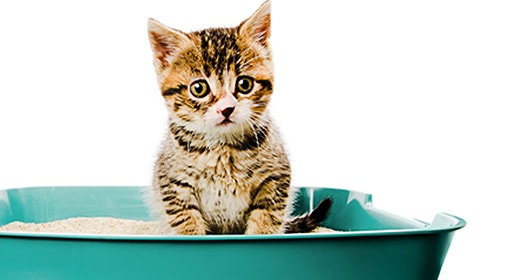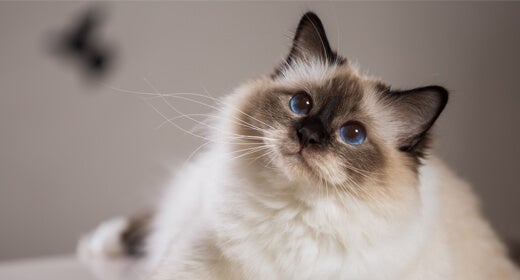

Caitlin Lewis, Community Outreach Manager for the Humane Society of Greater Dayton, dispels common myths about litter-box training for cats. In addition, she shows what and what not to do to help get your cat using the litter box as quickly as possible.
Hi, I'm Caitlin Lewis, Community Outreach Manager for the Humane Society of Greater Dayton on behalf of IAMS. Today we're going to learn how to train—or retrain—your cat to use the litter box. Contrary to popular belief, mother cats do not teach their kittens to use the litter box. Kittens begin to dig in and use dirt and dry, loose material at just a few weeks old without ever having observed their mothers doing so. This natural instinct is used in training kittens to use the litter box. Until your cat is reliably house trained, she should not have free run of your home. When you leave the house for any length of time, your cat should be confined to a single room, preferably one with nonporous floors, such as a kitchen, bathroom, utility room, basement or garage. Provide your cat with a bowl of water and a warm place to sleep at one end of the room, and a freshly clean litter box at the other end.
Until the house soiling has been cured, your cat should have a regular feeding schedule so she will develop a corresponding litter box schedule. In order to reward your cat for using her litter box, you must be there at the time she uses it. Most cats, especially kittens, will need to go shortly after waking, after eating, and after exercise. To help predict when your cat will go, feed her at regular times. If the input is on a regular schedule, the output will follow likewise. Call her to the litter box from a variety of places around your house, especially areas where she has soiled. When your cat gets to the box, scratch the litter to get her interested. Similarly, throughout the day, whenever your cat has been asleep for over two hours, wake her up and call her to the litter box. Encourage your cat to hop into the litter box and praise her when she does so. Even if she does not go, she's learning that the litter box is a great, clean place to be. If your cat does use it, then praise her in a gentle voice. When she is finished, gently stroke her, give her a treat, and let her know how pleased you are with her behavior. If mistakes occur, pick up the cat and set her down in the box. Do not discipline just before placing the cat in the box. The cat will associate any reprimand with being placed in the litter box, and will assume the litter box is the wrong place to go. Punishing a cat after the fact teaches her to be afraid of you. Never rub your cat's nose in a mess, or bring her over to it for a reprimand. She will have no idea why she's being reprimanded. But she may be inclined to eliminate in hidden spots, such as behind the sofa, to avoid another reprimand. Basically, punishment doesn't work with cats. Prevention and praise for getting it right are the keys to training. Clean any accidents immediately with half and half solution of white vinegar and water. This will help to eliminate the odor, and hopefully prevent kitty from returning to that spot. Consider covering the area with a plastic sheet; this will make it unpleasant for your kitty and discourage her from going there again. When your cat is still learning to use the box, leave a tiny bit of urine or feces behind in the box. The scent will remind her what the box is for. As soon as she is using the box reliably—and this could be as quickly as a day or two—remove all liquid and solid waste regularly. Scoop out solid material once or twice a day, and stir the litter to keep the surface dry. If your cat is having trouble using or finding the litter box, move it to an area where she can start seeing it all the time. When she stops playing and start sniffing or scratching at the floor, gently place her in the litter box. If your cat or kitten suddenly stops using the litter box for no obvious reasons, then take your cat to the veterinarian as soon as possible. Once your cat gets into the hang of finding the litter box and using it, they should have this skill for life. Now, let's recap. Provide your cat with a clean litter box that's easy to access. Get her interested in the litter box by scratching the litter. Reward your cat for using her litter box immediately after she uses it. And remember, prevention and praise are the keys to training. Punishment does not work with cats. I'm Caitlin Lewis on behalf of IAMS.


Your cat’s skin and coat help keep viruses and bacteria from entering the body and prevent water and heat from leaving it. And because nutrients such as protein, fat, vitamins and minerals play crucial roles in your cat’s skin and coat health, it’s important to make sure your cat is receiving the right types and amounts. IAMS™ cat foods are designed to provide your cat with the nutrition they need to support their skin and coat health.
Without Proper Nutrition
With Proper Nutrition
Your cat’s hair coat is composed almost entirely of protein. If your cat’s diet doesn’t contain enough quality protein, her hair may fall out or become dry, weak and brittle.
But not all proteins are alike. Proteins are found in both animal- and plant-based ingredients. Animal-based proteins contain all of the essential amino acids cats need, while plant-based proteins may contain only some. Cats need the nutrients in animal-based protein sources for the best health.
Fats also can be found in both animal- and plant-based ingredients, and are incorporated into skin cells as fatty acids. Three fatty acids help maintain your cat’s skin and coat condition:
Without these fatty acids, cats may experience a dull, dry coat, hair loss and greasy skin.
To promote your cat’s skin health and elasticity, make sure to provide clean, fresh water at all times.
Most cat foods contain more than the required amount of linoleic acid, an omega-6 fatty acid. However, IAMS research shows that it is not just the amount, but the ratio of omega-6 to omega-3 fatty acids that is most beneficial to cats.
The optimal omega-6 to omega-3 fatty acid ratio to maintain a healthy skin and coat in cats is between 5:1 and 10:1. In other words, five to 10 omega-6 fatty acids should be present for every one omega-3 fatty acid.
Vitamins and minerals are essential for the development of healthy skin and coat. The best way to provide them is through a complete and balanced diet rather than through supplements.
| Vitamin or Mineral | Role in Skin and Coat Health |
| Vitamin A | Necessary for growth and repair of skin |
| Vitamin E | An antioxidant that helps maintain the health of skin cells |
| Vitamin C | An antioxidant that helps maintain the health of skin cells |
| Biotin | Aids in the utilization of protein |
| Riboflavin (B2) | Necessary for fat and protein metabolism |
| Zinc | Necessary for fat and protein metabolism |
| Copper | Involved in tissue, pigment, and protein synthesis |
The protein, fatty acids, vitamins and minerals in your cat’s food all play a vital role in your cat’s skin condition and coat health. While other factors, including the season and your cat’s age, can also affect the health of your cat’s hair and skin, optimal nutrition can help support a shiny coat and healthy skin.